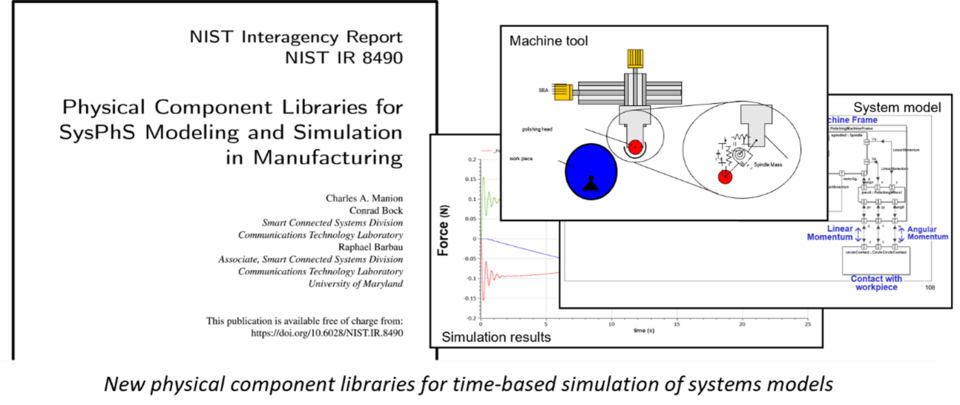
NIST published Physical Component Libraries for SysPhS Modeling and Simulation in Manufacturing, a NIST interagency report (NIST IR 8490) by Charlie Manion, Conrad Bock, and Raphael Barbau that significantly expands the capabilities of the SysML Extension for Physical Interaction and Signal Flow Simulation (SysPhS), a standard published by the Object Management Group (OMG) for modeling time-based (1D) physical and signal behavior in complex systems designs, as well as translating models to two well-known 1D simulation platforms that give same results on both platforms. This kind of modeling and simulation is applicable to many kinds of physical interaction (such as mechanical, electrical, and so on) as well as communication of numeric and boolean signals, though current SysPhS physical component libraries only utilize electrical interaction. SysPhS extends OMG's Systems Modeling Language (SysML), the most widely used standard for systems engineering information modeling, and which is widely implemented by major SysML tool vendors.
The report augments SysPhS physical component libraries for
- Translational mechanics: Includes translational inertia, springs, and dampers and other components that interact via linear momentum.
- Rotational mechanics: Rotational analogs of the translational components above, which interact via angular momentum.
- Heat transfer: Includes conduction, convection, and radiation, which interact via entropy.
Models built from these libraries translate to simulation platforms in the standard way, giving the same results on both platforms. The report demonstrates this with three examples of manufacturing system models using these libraries:
- Weight compensating robot: collaborates with people to handle heavy objects, such as positioning a large tool during manufacturing or guiding an object through a complex path during assembly, by compensating for its weight.
- Fused deposition modeling: melts a plastic filament in an extruder and deposits it on a surface, layer by layer, to make three dimensional shapes, used by most 3D printers.
- Polishing machine: moves an abrasive tool (rotary or belt) over a part while applying a constant normal force to it.
The above examples employ the new physical component libraries to model physical structure and behavior, as well the current SysPhS signal libraries to control them. The report gives results of translating to two simulation platforms using software developed by NIST’s Raphael Barbau, showing they produce similar results.
Manion presented the new libraries to OMG for future updates to SysPhS, as well as to the Aerospace Corporation for application to space systems. They are also being used in ongoing work with Boeing to expand SysPhS thermal capabilities to fluid flow. The work is part of NIST’s Systems Analysis Integration (SAI) project, which increases the efficiency of engineering processes by integrating a variety of engineering analyses with SysML, enabling engineers of all kinds to reliably share information and results with each other.

